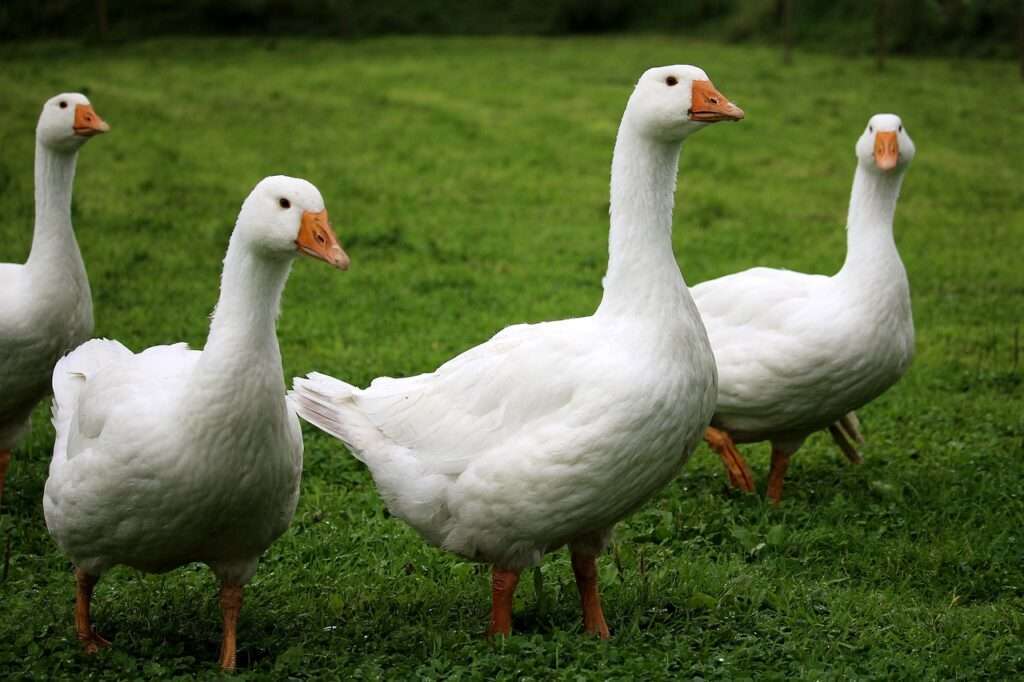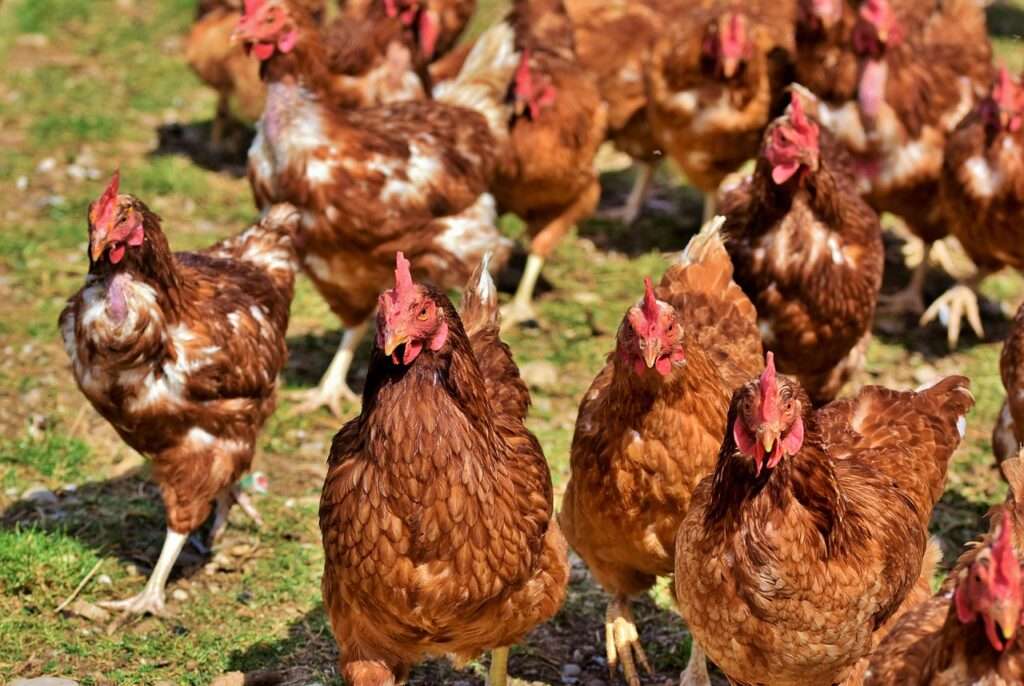Going to a restaurant for roast goose to celebrate St. Martin's Day is becoming increasingly popular. This is reflected in the growing number of hatched and fattened geese in the Czech Republic, which this year, according to the Czech-Moravian Poultry Breeders' Union, is estimated at almost 179 000. This means that breeders will supply the market with a total of more than one million goose portions. The rest of the demand for the traditional St Martin's Day dish will be supplemented by imported, but lower quality, aquatic poultry or cheaper ducks.
The medieval tradition of St. Martin's Day celebrations, which were connected with the end of the agricultural year, has persisted to the present day. The custom of serving roast goose as part of the celebrations has also continued, although Czechs increasingly prefer to visit a restaurant rather than roast it themselves. If restaurants offer goose of domestic origin, they usually boast about it in their advertising. These tend to come from smaller farms and are of higher quality because they are fattened in the traditional way in combination with grazing, which makes farming more expensive.
"If people really want to enjoy this year's St Martin's Day celebrations, they should reach for the goose of domestic origin. It is better quality, its meat is more tender and it is generally tastier, not least because it has not travelled hundreds of kilometres across Europe in trucks. Moreover, goose breeding is a traditional activity in the Czech Republic and breeders continue to keep it up, even though the overall situation of the domestic poultry industry is not good. The combination of low prices and high costs, compounded by the increasing demands of farming, only deepens farmers' uncertainty about the future," says the President of the Agrarian Chamber of the Czech Republic Jan Doležal.
Although customers will pay more for Czech goose for the reasons mentioned above, they are in greater demand than imported ones, as evidenced by higher domestic production. This year alone, according to official data, 166 904 of these waterfowl hatched in the Czech Republic, up 9 percent year-on-year. After taking into account exports and imports, the Czech-Moravian Poultry Breeders' Union estimates that 178 654 of these poultry were fattened this year. Each goose produces roughly six portions, making 1 071 924 portions for this year's St Martin's Day celebrations.

Development of hatched and fattened geese and ducks (thousands)
| Year | Hatched geese | Fattened geese | Hatched ducks | Fattened ducks |
| 2016 | 185 | 144 | 15 388 | 4279 |
| 2017 | 178 | 144 | 15 984 | 5306 |
| 2018 | 184 | 152 | 17 146 | 5877 |
| 2019 | 175 | 155 | 14 410 | 5286 |
| 2020 | 171 | 159 | 13 458 | 6960 |
| 2021 | 182 | 162 | 10 249 | 4536 |
| 2022 | 139 | 168 | 14 908 | 5258 |
| 2023 | 154 | 169 | 16 286 | 4871 |
| 2024 | 167* | 179* | ** | ** |
* Period January-June 2024, but the data can be considered final for the whole year. Rearing of fattening geese is seasonal, they hatch only until mid-year. In the case of fattening, this is an estimate of the CMDU.
** Data not available. The ducks are bred year-round and hatch all year round.
This season, according to market information, customers will pay CZK 500 to CZK 700 per portion including a side dish, depending on the location and the level of the establishment. The whole menu including foie gras, foie gras kaldoun and dessert in the form of apple strudel or other traditional dessert costs CZK 1,000 or more. Celebrations are also associated with the consumption of young St. Martin's wine and the price for lunch or dinner per person can be even higher.
A cheaper option is to prepare a traditional foie gras menu at home, although baking is more laborious. The price of a Czech goose directly from the breeder is around CZK 250 per kilo or more, with the whole goose including offal weighing at least 3.5 kilos. If booked early, it can cost less. Alternatively, a smaller and cheaper duck or goose imported from Hungary or Poland is also an option.
"Those who are accustomed to preparing roast goose at home every year usually reserve it a year in advance. It is not unusual for breeders to sell out before the St Martin's Day celebrations and it becomes impossible or expensive to find a goose of domestic origin. This year is no exception and only a few breeders have spare capacity. No wonder, because this goose meat is tastier and of higher quality. This is also due to the fact that the type of geese reared in the Czech Republic is different from that of foreign competitors,' explains the chairwoman of the Czech-Moravian Poultry Breeders' Union Gabriela Dlouhá.

The scarecrow of bird flu, no longer seasonal
Bird flu, which is spreading through Europe as in previous years, is a serious concern for farmers. Outbreaks in domestic and commercial breeding are increasing and the Czech Republic is no exception. Waterfowl, which are geese and ducks, are particularly susceptible to this highly pathogenic disease. The Agrarian Chamber of the Czech Republic and the Czech-Moravian Poultry Breeders' Union are monitoring the situation and are in contact with the supervisory authorities. Both organisations are also calling for compliance with biosecurity rules.
"Since avian influenza has lost its seasonality, strict adherence to biosecurity rules is necessary throughout the year. The basic preventive measure is to keep poultry in closed buildings and avoid contact with wild birds. In farms where confinement is not possible, measures must be taken to minimise the risk of contamination of water, feed and litter by wild bird droppings, for example by placing water and feed under shelter. The movement of poultry on water areas where wild birds are present should also be avoided. Any suspicion of disease, such as increased poultry mortality, a sudden drop in laying or feed intake, should be reported immediately to the regional veterinary authority," says the Director of the Veterinary Section of the State Veterinary Administration Petr Šatrán.
This is not the only problem facing the domestic poultry industry. The ban on cage-type housing for laying hens will come into force in two years' time. However, this will be a ban on rearing and not on selling, so supermarket chains will be able to continue to offer these eggs, and the same applies to eggs used in catering. It is therefore to be expected that domestic eggs will be replaced by those from cage-free farms abroad, including third countries, where no similar ban is in force or is being considered. In addition, there is a continuing interest in cage eggs, as Czech consumers are often price-oriented and do not want or cannot afford to pay extra for eggs from alternatives.
All this will lead to a deterioration of the competitiveness of Czech breeders on the domestic market. At the same time, it forces them to consider whether it will be worthwhile for them to continue breeding laying hens, which would lead to a sharp decline in the Czech Republic's self-sufficiency in egg production. According to a questionnaire of the Czech-Moravian Poultry Breeders' Association in October this year, more than three million housing places out of a total of about six million of all types have been converted to alternatives so far. On the other hand, over one million housing places are not planned to be converted at all.
Laying hen numbers by housing type
Current status as of 31 December 2017
| Type of technology | In thousands of pieces | In percentage |
| 0 - bio | 14,6 | 0,3 |
| 1 - enclosure | 8,4 | 0,2 |
| 2 - floor breeding, aviaries | 580,6 | 12,0 |
| 3 - enriched cages | 4255,3 | 87,5 |
| Total | 4858,9 | 100,0 |
Current status as of 31 December 2023
| Type of technology | In thousands of pieces | In percentage |
| 0 - bio | 34,6 | 0,6 |
| 1 - enclosure | 103,4 | 1,8 |
| 2 - floor breeding, aviaries | 2571 | 45,2 |
| 3 - enriched cages | 2981,9 | 52,4 |
| Total | 5690,9 | 100,0 |
AKCR/ gnews - RoZ
ILLUSTRATIVE PHOTO - pixabay



